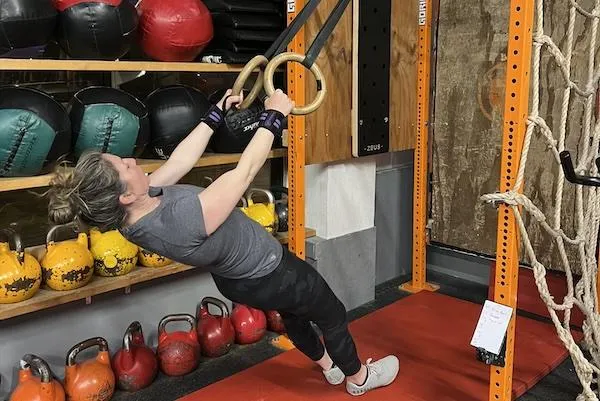
Preserving the Stimulus: When Med Ball Slams Beat Step-Ups
One concept I hadn’t really thought about until I started studying for my CrossFit Level 1 seminar is the idea of the “intended stimulus” of a workout or movement.
It’s a foundational part of good coaching—especially when it comes to scaling or substituting. As coaches, our job isn’t just to make a movement easier when needed. It’s to help each athlete preserve the intended stimulus so they still get the same kind of training effect, even if we adjust for intensity or make substitutions because of an injury or limitation.
Let’s look at two examples of workouts with very different intended outcomes.
What is “intended stimulus,” anyway?
Take Fran—the benchmark WOD. This is the intended stimulus as described in the Level 1 manual:
“A classic benchmark that allows coaches and athletes to assess progress. Fran, a couplet of gymnastics and weightlifting movements, is a relatively fast workout elite athletes finish in under two minutes. The complementary movement patterns—lower-body push and upper-body pull—allow for relatively continuous movement. The greatest challenge is managing an extremely high heart rate.”
The goal here? Move fast, keep the heart rate high, and go hard.
Now compare that to a heavy day like 5-5-5-5-5 back squats:
“A single-modality weightlifting heavy day. The sets are ascending (add weight each set). At 5 reps per set, the workout leans toward strength-stamina versus top-end strength. The goal is to lift as heavy as possible for five reps with solid technique. Athletes should rest 3–5 minutes between sets to maximize loading.”
Totally different vibe, right? The goal of one is intensity under fatigue. The other? Maximal strength with full recovery.
Intended stimulus applies to movements too
The concept of intended stimulus doesn’t just apply to workouts—it also applies to the individual movements within them. And depending on the context of the workout, the purpose of a movement might change.
I saw a great example of this in a recent class I shadowed with WOD Father.
The workout that day included box jumps. One of the athletes had a lower-body injury and couldn’t jump. Normally, you’d expect to see a swap to box step-ups. But that’s not what happened.
Instead, Corey gave them med ball slams.
Wait… med ball slams? That’s not even in the same movement pattern as a box jump.
True—but it matched the stimulus in this particular case.
It’s about matching the effect
In this case, the purpose of the box jump was to spike the heart rate. Box step-ups, while a common scaling option for box jumps, wouldn’t deliver the same effect. But med ball slams—quick, powerful, full-body—absolutely would.
That was a lightbulb moment for me.
I used to think of scaling as “making something easier.” But now I understand—it’s not about mimicking the movement. It’s about matching the effect.
If the movement is supposed to:
Challenge your core stability, the scaled version should still challenge that stability.
Elevate your heart rate, the alternative should do that too.
Improve range of motion, then the scaled movement should support that goal.
Scaling is about achieving the same outcome, not doing the same thing.
Scaling isn’t just substitution
It’s also important to know that substituting a movement is usually the last option an athlete should pick.
When an Rx workout is too intense to preserve the intended stimulus for an athlete, the first step should be to scale the intensity by reducing:
Load (use less weight)
Speed (slow down the pace)
Volume (cut the reps)
Only if a movement can’t be done at all—because of injury, mobility, or safety—do we sub in something different. And when we do, we’re not just throwing in any old exercise. We’re looking for one that achieves the same purpose.
Fitness for Every Body
Now when I look around the gym and see different athletes doing different things, I don’t just see modifications—I see thoughtful coaching.
I see people of all levels working hard, pushing their limits safely, and getting stronger.
And I see what Empower really means when we say: fitness for every body.
If you like to geek out on this stuff, here’s a good resource:
The workout for Saturday, July 19
H: 03-10 Warm up (7 min)
For overhand movement:
Use a resistance band, pulling away from the bar.
Facing away, with an arm overhead and facing sideway, facing the bar and do small circles
Chest stretch, elevated elbows stretch
For core, hip, and posterior chain activation:
Bird dog, floor bridge, hip flexor stretch
H: 10-25 Tech (15 min)
TGU
Points of Performance:
Place the KB between your index finger and thumb, landing on the web space
The starting position is from side when using heavy KB
The same side of arm and leg are on the ground; raise the other side
Always looking at the celling/KB
Pay attention to the guy in the video: his arms are aligned when getting up
Fully open your hip to leave the ground
Stand up on your heel of the front foot, knee and foot of the back foot
The reverse sequence when lying down: knee, hand and heel, hip, elbow and shoulders
Single-arm OHS
Keep your core tight. Lock out your elbow by the side of your ear. Use the other arm to balance if needed. Breathe in, squat into your heels.
GHD sit-ups
Position your hip angled on the pad.
Fully open your knee and hip. Sit up with the assist of kicking.
Progression: V sit-ups
H: 25-30 Set up for the workout
H: 30-45 WOD
Complete as many rounds as possible in 15 min of:
20 KB TGU @1/1.5 pood
30 GHD sit-ups
40 KB single-arm OHS @1/1.5 pood
30 GHD sit-ups
Notes:
1 pood is 36 lb; 1.5 pood is 54 lb.
Split reps of TGU & OHS between left & right hand evenly using any rep scheme you prefer
For individuals:
This is a high-volume GHD workout. Do not try to finish them all if you cannot do 10 in a row.
The alternative strategy is to limit the first set of GHD to the largest set you can handle, then move on to the next movement.
For team:
Finish the KB movement synchronized with your partner.
Split the 30 GHD sit-ups with standard movement or progression.
H: 50 Cool down (5 min)

